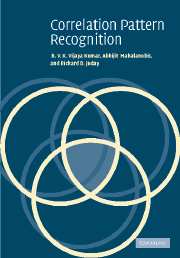Book contents
3 - Linear systems and filtering theory
Published online by Cambridge University Press: 06 August 2009
Summary
Correlation involves two signals or images. A reference image is correlated with a test image (also called a scene) to detect and locate the reference image in the scene. Thus the correlator can be considered as a system with an input (the scene), a stored template or filter (derived from the reference image), and an output (correlation). As we will see in this chapter, such a system is linear in the sense that a new input that is a weighted sum of original inputs results in an output that is an identically weighted sum of the original outputs. Thus a correlator can take advantage of the many properties of linear systems. The most important property is that a linear, time-invariant system can be characterized in terms of its frequency response. We use this and other related properties for the synthesis and use of correlation filters with attractive features such as distortion-tolerance and discrimination. In this chapter, we provide a review of some of the useful properties of signals and linear systems.
Basic systems
Strictly speaking, the signal is denoted s(·), and s(x) is the value of s(·) when the argument value is x. We will occasionally require the strict notation, but usually there is no confusion from writing s(x) to mean “s(·) with x being used as a general value for the argument.” Figure 3.1 is a simple block diagram of a system.
- Type
- Chapter
- Information
- Correlation Pattern Recognition , pp. 48 - 107Publisher: Cambridge University PressPrint publication year: 2005



